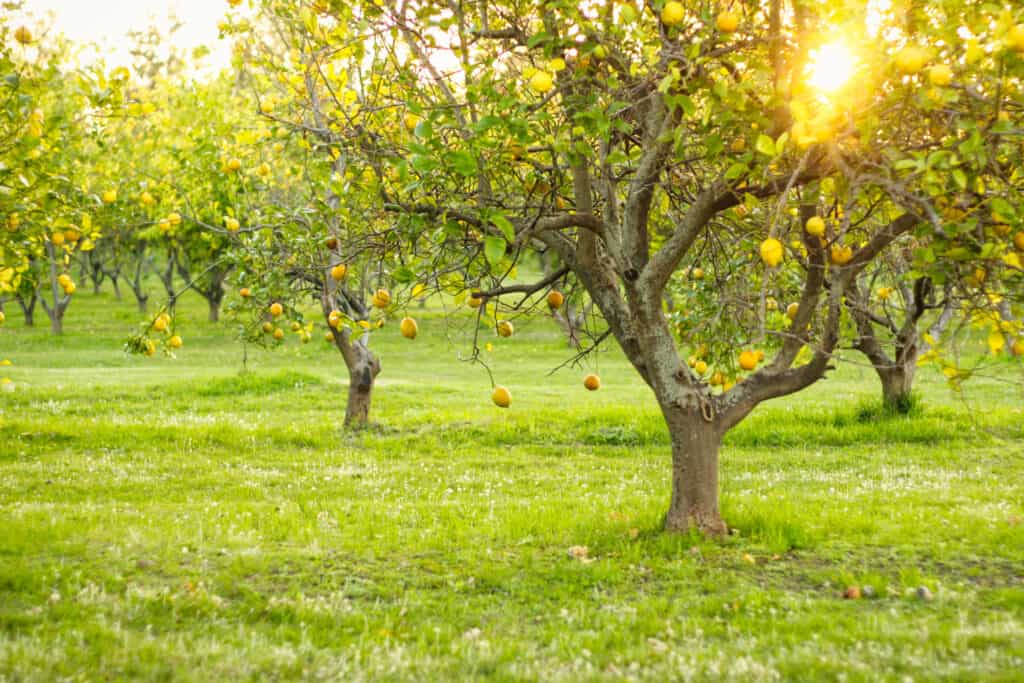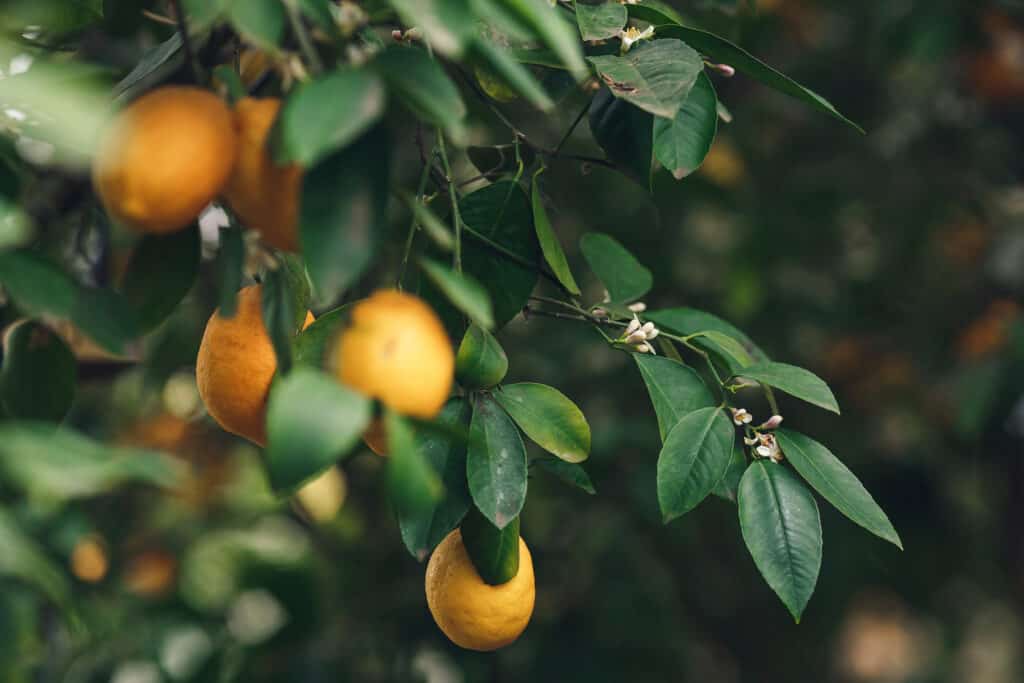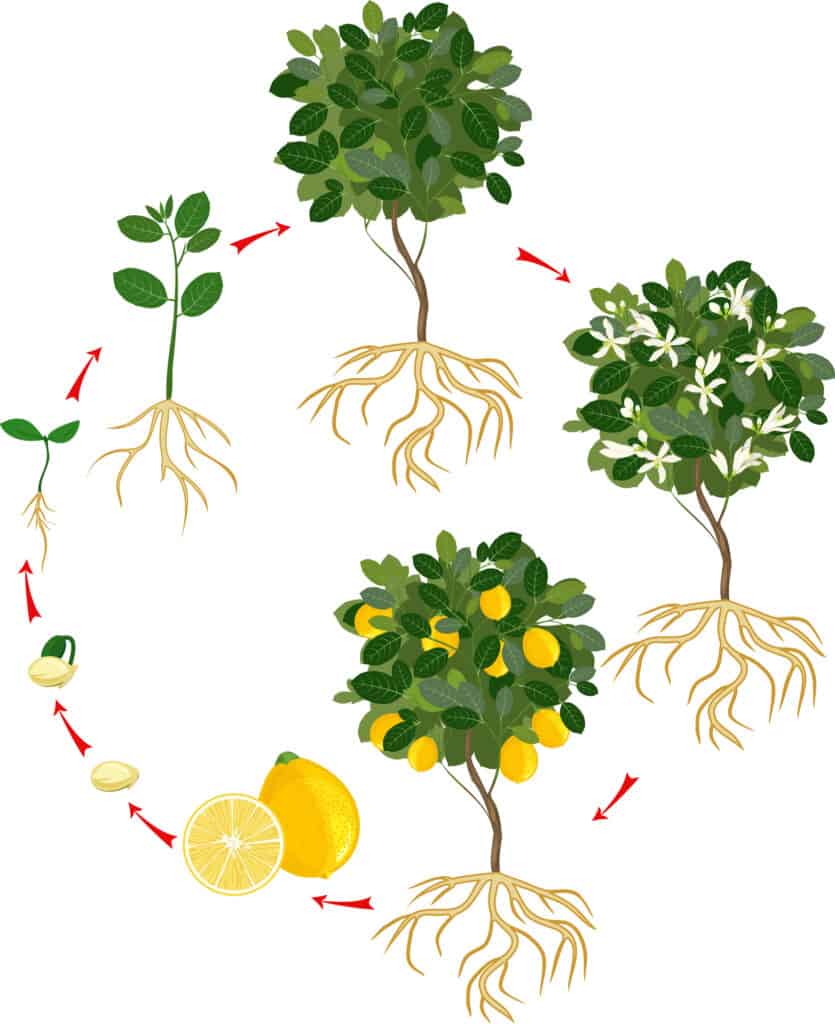Imagine opening a window during a breezy spring day and smelling the clean, citrus scent of your lemon tree planted nearby. Growing citrus trees, especially lemons, can be tricky because they are susceptible to cold. So, you may be wondering, “Can lemon trees grow in Texas?”
Yes, lemon trees can grow in Texas, but it depends on your location and growing conditions. Find out the best lemon trees to grow in the state and how to care for them.
What are the Best Lemon Trees to Grow in Texas?
In Texas, you can grow true lemons (real lemons) or hybrid lemons like Ponderosa and Meyer.
True Lemon

Lemon trees can grow in Texas, but it depends on your location. The true lemon varieties Eureka and Lisbon grow best in Texas.
©iStock.com/lucop
The true lemon is a small evergreen tree from the Rutaceae flowering plant family. It is native to Asia, possibly Northeast India, Myanmar, or China. Christopher Columbus brought lemon seeds with him on his voyage to the Americas in 1493, but they were mainly used as ornamental plants.
It wasn’t until the 19th century that people began producing fruit, mainly in Florida and California. There are several types of true lemons, but “Eureka” and “Lisbon” grow the best in Texas. Eureka occurs in spring and summer, and Lisbon in the summer and fall.
Ponderosa Lemon
The Ponderosa lemon is a citrus hybrid, a cross between a pomelo and a citron. Its tree is small and thorny, and its citrus fruit is large and seedy with a bumpy-like texture on its rind. The Ponderosa is mainly ornamental and not typically used for producing fruit. This hybrid species is also more cold sensitive than true lemons, although both have the same hardiness zones.
Meyer Lemon

Meyer lemons are the easiest type to grow in Texas.
©iStock.com/MarinaVarnava
Meyer lemons are hybrid citrus fruit, a cross between a citron and mandarin/pomelo hybrid native to China. It is the easiest lemon tree to grow in Texas and is more tolerant of the cold than true lemon species. Meyer lemons also have a sweeter taste than regular lemons, making them a favorite in classic desserts.
Are Lemons Legal in Texas?
It is not illegal to grow lemons in Texas, but it is unlawful to transport citrus plant material into Texas. Citrus plants, especially from Florida, carry diseases that can ravage the Texas industry. Most people are unaware that bringing citrus plants or even fresh citrus fruit into Texas from other states and countries is illegal. The state requires that all citrus plants be labeled “Produced in Texas.”
Where Can you Grow Citrus Trees in Texas?
The best area to grow lemon trees in Texas is the lower Rio Grande Valley, a region in deep South Texas. Texas has a wide-ranging growing zone from a 6 in the Panhandle down to a 10 in the Southern tip. Lemon trees have a hardiness zone between 9 and 11 and grow best in the most southern areas of Texas near the Gulf Coast.
Lemons are subtropical fruit that loves warm climates. They are drought resistant with proper watering but are incredibly sensitive to frost. However, these citrus trees can grow outside their preferred growing zone with excellent care. But fruit production may be significantly affected.
Lemon trees become inactive in temperatures below 55 degrees, and their fruit dies within 30 minutes of exposure to 28 degrees or below. Ensure you have a plan for proper cold conditions, like leaving it in a container, so you can quickly bring it indoors during the harsh winter.
How to Grow Lemon Trees in Texas

Stages of lemon tree growth from seed and sprout to adult with fruits
©iStock.com/mariaflaya
- To begin, find a spot on the south end of your home with full sun. Find a lemon tree at your local nursery between no more than 48 inches tall, with three or four side branches.
- Dig a hole twice the size in diameter of its container but one to two inches shorter in depth. Choose soil that’s well-draining.
- Remove the tree from its container and gently water the root ball until a couple of inches of soil fall away, revealing the roots.
- Place it in the hole and fill halfway with soil, water until it soaks through, and then add the rest of the soil to the top.
- Shape a ring of soil around the tree (six inches high and eight inches thick) and water the sapling until the circle is full. Repeat the watering every two to three days for two weeks. Then, reduce your watering to once every ten days. If the soil ring has disintegrated, you only need to water it once every two weeks.
How to Care For Citrus Trees in Texas
- Wrap aluminum foil around the base of the lemon tree to protect it from herbicides and to keep extra branches from sprouting.
- Fertilize the tree three times during its first year.
- Keep the soil around your tree (at least 12 inches) free from weeds and grass, which can rob it of nutrients.
- Citrus trees don’t grow well in salty soil; keep the PH level around six to eight.
- Keep your lemon tree at least six feet away from buildings, driveways, and fences. A suitable distance from structures and other trees is essential for tree size control and pruning.
- Don’t dig your hole too deep. If the bud onion is too low in the ground, it can contract foot rot and die. Don’t scoop out too much soil and grass for easy watering purposes.
- If you have good citrus soil, you do not need to mix your topsoil with peat moss, compost, or other material.
- It takes the watering ring around four to six months to erode. You can consider the tree well-established once this happens, and you will only need to water it with a soaker hose or sprinkler system.
- For cold protection, create a large soil bank as high as possible around the trunk and lower limbs. You can do this for the first two to four winters. Cover the bark with an insecticide before creating your mound, and then take caution when dismantling to prevent damaging the trunk.
Up Next:
- 17 Gorgeous Flowering Trees in Texas
- Azaleas in Texas: How to Care for Azaleas in Texas Climates
- What Texas Fruits Are in Season Throughout the Year?
The photo featured at the top of this post is © iStock.com/Denira777
Thank you for reading! Have some feedback for us? Contact the AZ Animals editorial team.






